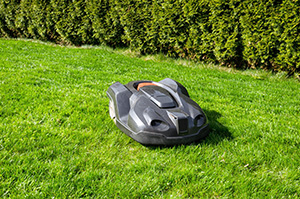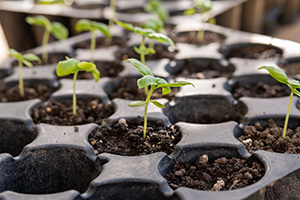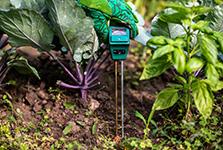Garden Gadgets

Our homes are becoming increasingly filled with gadgets that make life easier, and luckily there are quite a few for the garden too. Technological advancements have made it possible for lawn mowing and irrigation to be fully automated. There are tools to measure rainfall, soil moisture, and weather conditions that will send data right to your phone. Many are affordable as well, so a high-tech garden is within reach for everyone!
Robotic Lawnmower
You’ve likely already used or seen robotic vacuum cleaners, but did you know you can also get a robotic lawnmower? No more suffering in the summer heat to cut the lawn! You simply set a boundary for the mower and then program your desired settings such as mowing schedule and grass height. Features vary by model, but many can be controlled from your phone and/or connect to your smart home system. Expect to pay $600 for a basic model to several thousand dollars for a top-tier robotic lawnmower.
Smart Camera
Whether you’re hoping to birdwatch or see who is responsible for nibbling the greens in your garden, installing a smart camera might be the answer. Many types are available, such as cameras designed for mounting in a birdhouse or models with night vision for 24/7 wildlife monitoring. You can typically watch the footage on your phone or even on your TV. Lower-end models cost as little as $30, while those loaded with features can cost several hundred dollars.
Indoor Hydroponics Unit

Indoor hydroponics units are an easy way to grow veggies, herbs, and flowers within the comfort of your home. They are as simple to use as pod-based coffee machines; all you need to do is pop the pods containing soil and seeds into the machine and fill it with water. It has a lamp to provide light to your seedlings that you can move up as they grow. You’ll pay between $30 and several hundred dollars for the unit, plus an additional cost for the seed pods. Check out our tutorial for setting up a tabletop hydroponics unit.
Pollinating Tool
Growing fruits and vegetables in an urban area can be difficult due to a lack of pollinators. Fortunately, a handheld gadget exists that allows you to hand-pollinate your plants. It resembles a toothbrush, with bristles that vibrate. You simply move the vibrating tool from one flower to the next to distribute pollen. This tool is also helpful for indoor or greenhouse gardens, where pollinators cannot reach your plants. The price tag is quite reasonable, with most models costing between $15 and $50.
Self-Watering Containers
Remembering to water potted plants can be a struggle. Luckily, there are now plenty of containers on the market that can do it for you. They range in size from small pots to tall, vertical units, but they all contain water reservoirs that will send water up to your plant as it needs it. This means you only have to check the reservoir every once in a while! Prices for these containers are on par with regular pots of the same material, so they can be as affordable or luxurious as you desire.
Seedling Heat Mat

Seedling-germination rate depends in part on soil temperature, and that can be within your control with heating mats. These mats go underneath your seedling trays and keep the trays at the optimal temperature. They are also waterproof, so you don’t have to worry about spills. Prices vary based on the size, but they tend to run between $10 and $20 per mat.
Smart Rain Gauge
Irrigation doesn’t have to be a guessing game anymore. With a wireless rain gauge, all you have to do is check the digital screen to see how much rainwater your garden has received. Fancier models will check other weather conditions, such as temperature, humidity, and wind speed/direction. Some also have apps, so you can quickly check your yard’s weather data from your smartphone. Prices start at $30 for basic models and go up with additional features.
Soil Moisture Sensor

If you’re new to gardening, it can be hard to tell whether your plants need water or not. Luckily, all you need is a soil moisture sensor to precisely tell you when your plants are thirsty. Simply insert the sensor a few inches into the ground and it will indicate whether the soil is dry, moist, or wet. These sensors aren’t a major investment since basic models cost around $10 and fancier digital sensors start at $20.
Smart Irrigation
Your irrigation can be completely automated with a smart irrigation system. A smart irrigation system will calculate how much water to apply and when depending on weather conditions. You can check the system’s app to see how much water you’ve used and to alter your irrigation schedule. Some models can also be integrated into your home’s smart system if you have one. Prices vary by model, but they typically start at a hundred dollars for a unit with the features we mentioned.

Apps
There are many apps available to help you in the garden, but the UF/IFAS Center for Land Use Efficiency has developed several that are all based on the latest research. There’s one on Florida trees, a vegetable planting guide, a Florida-Friendly Landscaping™ plant guide, an app for landscape pests, and more. Get details about these apps and download them here.
As always, contact your county Extension office with any questions as you introduce new technologies to your garden.
Also on Gardening Solutions
More from UF/IFAS
- Beat the Heat With a Self-Watering Container Garden (IFAS Blogs)
- Smart Irrigation Apps: Urban Turf (Ask IFAS)
- Smart Irrigation Controllers: How Do Soil Moisture Sensor (SMS) Irrigation Controllers Work? (Ask IFAS)
- Smart Irrigation Controllers – Landscape Water Usage (IFAS Blogs)
- Video: Robotic Mowers for a Home Lawn (IFAS Blogs)
